When Fawn Pigg had trouble finding eggs at the grocery store, she decided she didn’t want to wait around for the supply chain to fix itself.

So, she went straight to the source: Live chickens.
An elementary school teacher in Poplar Bluff, Missouri, Pigg had wanted chickens for years. And with school canceled for the remainder of the academic year, she had the time to take on a new project.
But finding chicks turned out to be even harder than finding eggs. Local feed stores were sold out, and the hatcheries she called had waitlists months out.
The coronavirus pandemic has created a sense of urgency around chickens. Anxious about the availability of eggs, bored with staying home, or just yearning for something to love and nurture, people have been panic-buying little chicks in a big way.
I live in central Missouri, where backyard chickens have been popular since an ordinance allowing them passed in 2010. For several years my family kept a flock of 6, so I got to be part of a weird and wonderful cohort. My chicken curiosity was recently rekindled when a friend posted to Facebook that she would gladly take any birds people had “pandemic-purchased.”
We’ve all read about toilet paper and dried beans. Are people stockpiling chicks, too?
I chatted with nearly a dozen people to find out how the backyard chicken business has evolved over the past decade — and how it’s blown up over the past 2 months.
The backyard bird boom has been incubating for a while
There’s no official count on the number of people raising chickens, but a 2013 study by the USDA predicted that by 2019, 5% of Americans (13m people) would be trying their hands at hen keeping.
Sales of chickens and chicken-related products have grown steadily in recent years. Amazon has 80+ listings for prefab chicken coops. The cheapest is a simple hutch that sells for $179. The most expensive is a colonial-style cottage that sells for ~$2k.
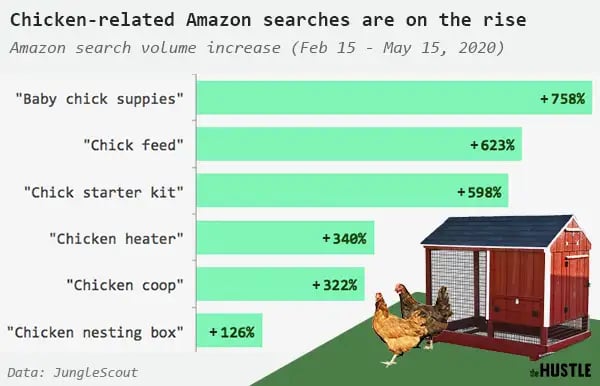
90-day search volume trends for certain chicken products on Amazon (The Hustle)
The trend has been fueled in part by interest in environmental sustainability. And for families, it’s an opportunity to teach children about animals and where food comes from.
Some people spend small fortunes on exotic breeds like the all-black Ayam Cemani (the so-called Lamborghini of chickens can fetch ~$200/chick) or the majestically monikered Westphalian Deathlayer (~$100/chick). Designer coops with high-tech considerations like solar panels and automated doors can run upwards of $20k. Others go the DIY route.
But newcomers to the hobby are encountering an unexpected barrier to entry: During black swan crises like COVID-19, everyone wants in on the chicken game.
The booming chicken market
Check out websites for hatcheries around the country and you’ll see you can buy all the cockerels you’d like, but pullets are sold out.
This is hardly a new phenomenon: During times of uncertainty — think the Great Depression or the build-up to Y2K — people look to ways to boost their self-reliance, whether it’s baking their own bread, gardening, or raising chickens.
“Any time there is a crisis, chick sales go up,” said Meghan Howard, webmaster at Meyer Hatchery in Polk, Ohio.
Meyer Hatchery has been inundated by calls, chats, emails, and sales. Howard said about 80% of orders are from new customers.
Traci Torres, the owner of My Pet Chicken, a hatchery in Monroe, Connecticut, said that during the 1st week of March, sales were at 98% of the previous year’s figures. By the 4th week, that figure had increased to 500%+.
“We have maintained that all the way through April,” Torres said. “Things have started to slow down, but only because there’s nothing left to sell.”

Chickens come in all shapes and sizes (Traci Torres / My Pet Chicken)
Hen hoarding has gotten so out of hand that some feed stores are setting limits on the number of chicks a person can purchase. It might seem extreme, but Kevin Crouch, a wholesale account specialist with Ideal Poultry in Cameron, Texas, pointed out, there’s no way to speed up chick production.
“If we could have predicted this, we could have put down more breeders back in October. But what we have is what we have. We’re buying chickens from other hatcheries,” Crouch said.
Along with chicks, coops and accessories have become hot items.
Johannes Paul, the co-founder of the UK-based pet supply retailer Omlet, said his company has sold 6 months’ worth of chicken products in just 6 weeks. Overall, chicken-related sales have increased several hundred percent since the pandemic hit, Paul said.
In addition to the brand’s signature Eglu hutch — which looks more like an old iMac computer than the barn-style coops most of us associate with chicken keeping — Omlet has done brisk business with chicken accessories including automatic door openers, expanded runs, treat dispensers, chicken leashes, and high-visibility chicken vests.
“People are seeing their chickens as a pet as well as an animal that will produce eggs for you,” Paul said. “They want to look after them the best way possible.”
Paul is among those who think of chickens affectionately rather than agriculturally. His family has four: Princess Laya, Hen Solo, and Nosh n Pecks, a nod to Brit power couple Victoria “Posh Spice” and David Beckham.
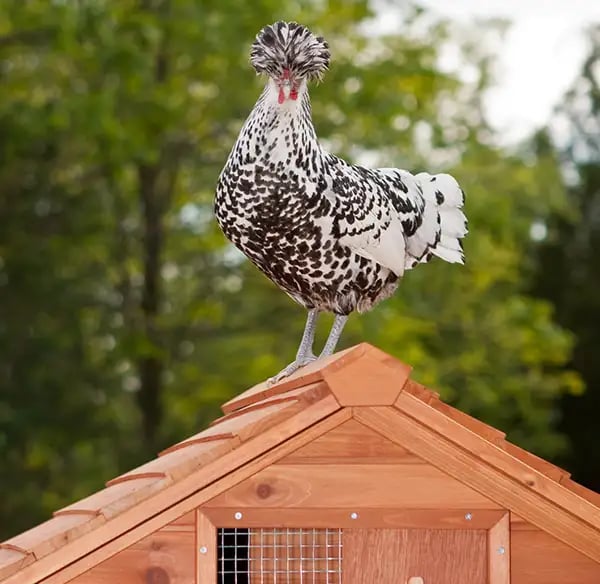
A castle befit for a king (Traci Torres / My Pet Chicken)
Torres, of My Pet Chicken, also has been moving a huge number of coops.
“We have sold out in advance of our latest batch of 500 coops. We sold out weeks before they even arrived on our shores,” Torres said.
To keep up with demand, she’s been calling manufacturers who have retired or changed business “and begging them” to reconsider making coops.
Eggnomics 101: It’s really a matter of joy
In times of egg shortage, having hens can seem like an attractive (and truly Instagrammable) way to kick out one link in the food supply chain. But backyard chickens don’t exactly pay for themselves.
There’s the initial investment into the birds themselves. A female chick costs ~$5 to $8 for a standard laying breed like an Australorp or Rhode Island Red.
Chicks typically need to be kept in a brooding box with a heat lamp. A sturdy cardboard box will suffice, but the heat lamp will set you back $13 to $75 and the chick feed is $8 to $25. Waterers will cost $6 to $30 and basic feeders are $4 to $15.
When the chicks get real feathers, they’re ready to move outside to the coop. An assemble-it-yourself-Ikea-style coop that houses 6 hens is ~$200 on Wayfair. From there you can spend as you want for deluxe designs from artisanal builders.
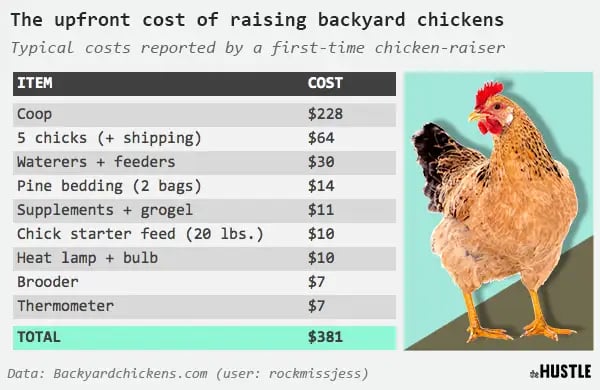
The Hustle
Aside from the initial investment in the birds and the coop — ~$260 on the low end — they require feed and some sort of bedding material – usually straw. It costs at least $35/month to keep 6 hens fed and bedded.
If each hen lays an egg a day, a flock of 6 will yield 15 dozen/month. That same 15 dozen will cost you about ~$19 at the grocery store, depending on where you shop. Even with egg prices tripling to $3+/dozen in some parts of the country, this is not a money-saving venture.
“We spend a lot more on feed than we would ever get back,” said Diana Moxon, a podcast host who keeps backyard chickens near where I live in Columbia, Missouri. “But you get the eggs and the joy … it far outweighs any price benefit to it.”
But learning the chicks of the trade can get messy
Moxon says raising chickens is not for the faint of heart.
Once, one of her beloved hens, Shamiqua, fell victim to something called flystrike. A fly had found a moist patch of flesh on Shamiqua’s rump and laid its eggs there. The larvae started eating into Shamiqua. Had Moxon not noticed them, they eventually would have munched their way to Shamiqua’s brain.
It took the help of two girlfriends and more than a little whiskey, but Moxon got the maggots out of Shamiqua’s butt.
“I can’t say how squeamish I am about worms and maggots. But, it’s this or death. The three of us are the only things between poor ol’ Shamiqua and chicken heaven,” Moxon said of the incident.
Four years later, Shamiqua is alive and clucking. She and her flockmate, Prudence, keep Moxon and her husband supplied with frittata fixings. But even chicken wranglers lucky enough to avoid the dreaded flystrike might find themselves in over their heads when they get their first birds.
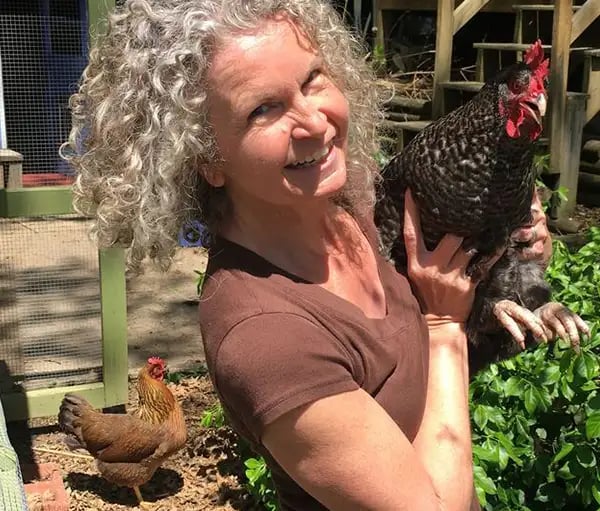
Diana Moxon with her chickens, Shamiqua (foreground), and Prudence (background) (Photo courtesy of Diana Moxon)
Marisa Erasmus, an assistant professor of animal sciences at Purdue University who specializes in poultry behavior and welfare, said that because people don’t tend to think of chickens in the same way they think of other animals such as large farm animals or cats and dogs, they might underestimate the amount of care the birds require.
They’re vulnerable to predators like raccoons, opossums, foxes, and hawks, so a well-built coop is necessary. They go through awkward and messy molting phases. Introducing new hens to an already established flock can bring bitter in-fighting as each jockeys for power in the new pecking order.
I experienced this first hand when I replenished my own flock with 2 new birds. Salt — or maybe her sister Pepa, who looked just like her — was the lowest-ranking girl in the group. She bullied the new ladies mercilessly, eventually pecking a hole in one hen’s neck.
Chickens can turn to cannibalism if they develop a taste for blood. To nip the problem in the beak, I put pinless peepers (a type of blinder) on Salt and Pepa. The peepers looked a lot like Kanye West’s infamous shutter shades, but they did the trick.
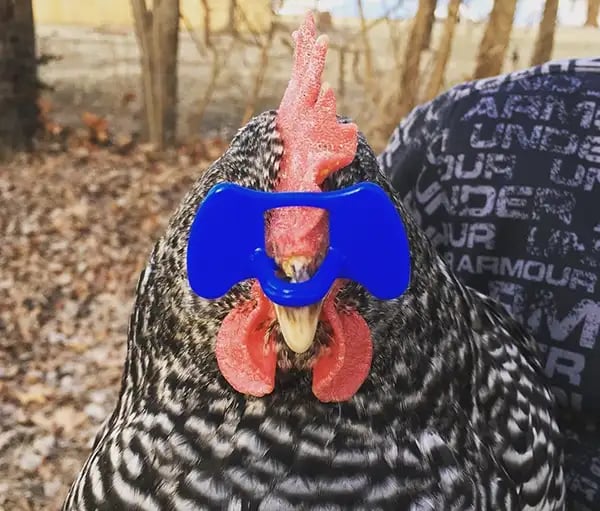
The author’s chicken sporting her Kanye shades (Caroline Dohack)
Erasmus isn’t opposed to people keeping backyard chickens. Her own grandparents had a backyard flock when she was growing up.
“I think raising chickens can be really rewarding. There’s lots of evidence that people do derive benefits from caring for animals, having pets and interacting with other animals,” Erasmus said.
However, she hopes aspiring chicken handlers will educate themselves on all the avian ins and outs so they’re prepared to care for their chickens for the bird’s entire life span.
Meanwhile, a growing number of people in the chicken biz are committed to helping buyers avoid poulette pitfalls.
Meyer Hatchery has invested in educational YouTube videos, a podcast and a blog. Chat teams are trained to answer questions. It’s also redesigned its shipping boxes to include a QR code that directs to a landing page with information about caring for the birds.
The rental hen market also is egg-sploding
Sometimes the best way to learn something is to do it. And wouldn’t you know it: Chickens-as-a-Service has become a thing.
Rent the Chicken is a network of farmers in the US and Canada who deliver chickens, portable coops, and all the necessary supplies to people wanting to give chicken-rearing a test run, or for those who want to keep chickens only part-time.
The company’s co-founder, Jenn Tompkins, said she expected business to dry up this year because people facing furloughs or layoffs wouldn’t want to throw money at borrowed birds. It turned out she was “dead wrong:” The waitlist in Toronto is now 175+ deep.
“We usually sell out in Toronto in March. Last year there were only 30 people on the waitlist,” Tompkins said.
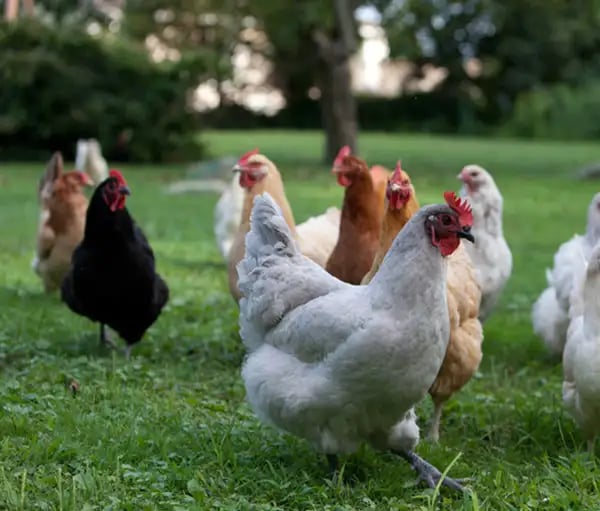
Chickens roam the yard (Traci Torres / My Pet Chicken)
Rent the Chicken had been growing steadily since 2013, and to meet the anticipated increases a normal year would have brought, Tompkins had worked with farmers and suppliers to increase the coop inventory by 100 and order more chickens to increase the number of flocks. Now the affiliates are working to increase the inventory even more.
“We’re building more coops than ever,” Tompkins said. “This year is blowing last year out of the water.”
Waiting for sustenance
Back in Missouri, Fawn Pigg has yet to enjoy the eggs of her labor.
Last month, she connected on Facebook with a woman looking to offload some chicks. She’s now the proud owner of 12 Buff Orpingtons. They’re still just peeping balls of yellow fluff, but they’ve become part of the family. Every morning, Pigg and her significant other sit in the garage drinking coffee and talking to the birds about the latest news headlines.
Although it will be at least another 5 months before they start laying eggs, the chickens are something of a doomsday insurance policy for the elementary school teacher.
“If there’s another pandemic,” she said, “we have a sustainable food source.”

